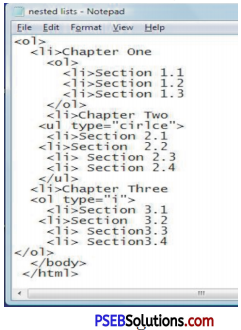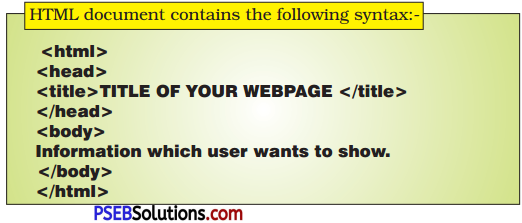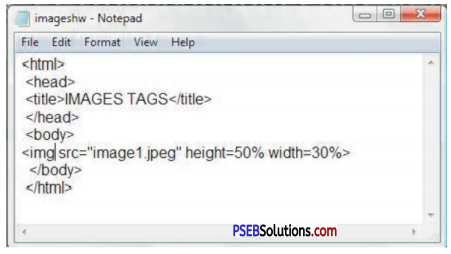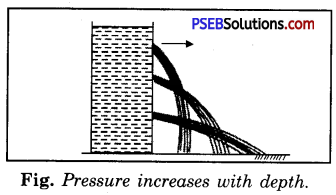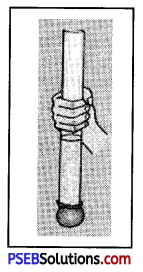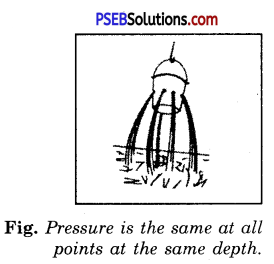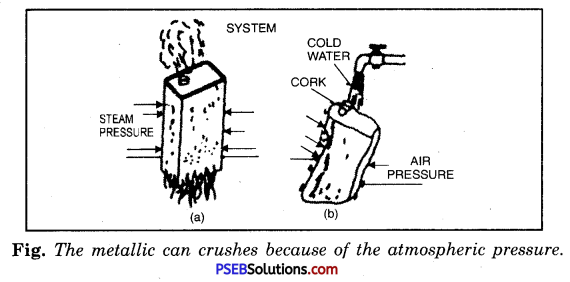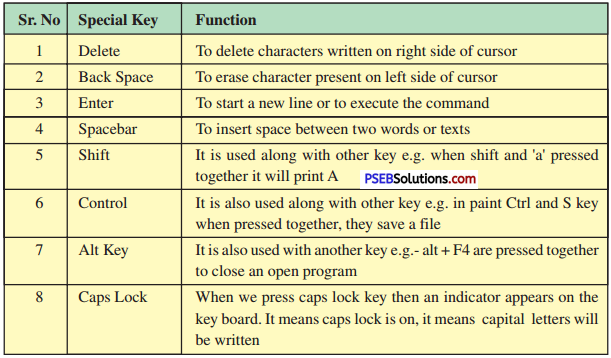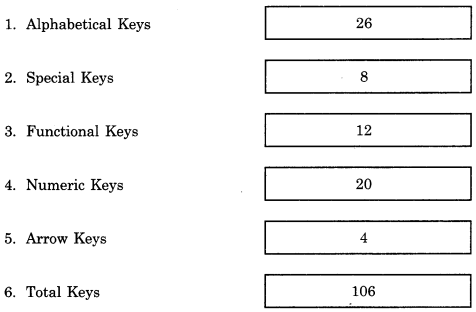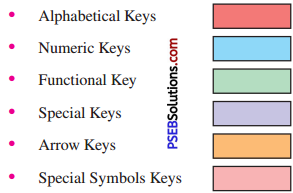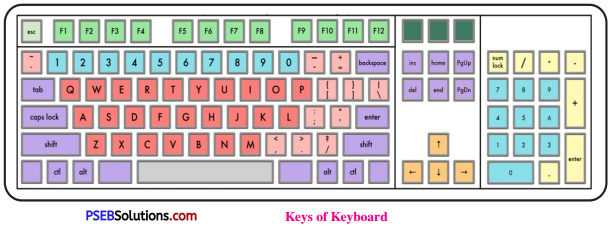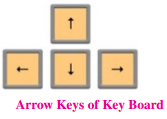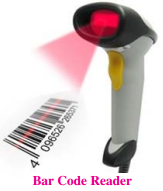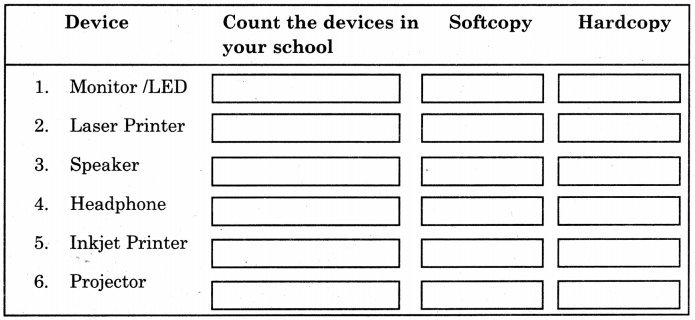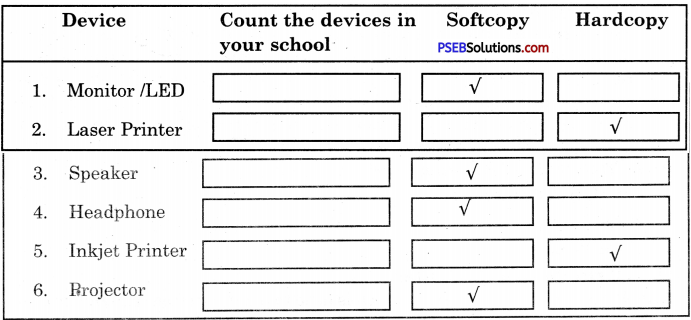Punjab State Board PSEB 10th Class Agriculture Book Solutions Chapter 3 Rabi Crops Textbook Exercise Questions and Answers.
PSEB Solutions for Class 10 Agriculture Chapter 3 Rabi Crops
Agriculture Guide for Class 10 PSEB Rabi Crops Textbook Questions and Answers
(A) Answer in one-two words:
Question 1.
Name any two oilseed crops.
Answer:
Raya, Linseed.
Question 2.
Name any two improved varieties of wheat.
Answer:
H.D. 2967, DBW 17.
![]()
Question 3.
How much seed is required to sow one acre of Raya?
Answer:
1.5 kg seed per acre.
Question 4.
Name two insect-pests of gram.
Answer:
Termite and gram caterpillar.
Question 5.
Name any two diseases of wheat.
Answer:
Kamal Bunt, yellow rust.
Question 6.
Name any two weeds of wheat
Answer:
Canary grass (gullidanda), Senji (sweet clover), Maina (toothed bur clover), Maini.
Question 7.
Which crop is known as king of fodders?
Answer:
Berseem.
Question 8.
What is the sowing time of lentil?
Answer:
Second fortnight of October.
![]()
Question 9.
Name any two improved varieties of barley.
Answer:
PL 807, PL 426.
Question 10.
How much is the oil content in sunflower seeds? Or What percent of oil found in sunflower seeds?
Answer:
40-43%.
(B) Answer in one-two sentences:
Question 1.
Write the per acre nutrient requirement of wheat.
Answer:
50 kg nitrogen, 25 kg phosphorus and 12 kg potash per acre.
Question 2.
Name two wheat based crop rotations.
Answer:
Rice-wheat, cotton-wheat.
![]()
Question 3.
In which crop and against which weeds herbicide Total is used?
Answer:
Total is used in wheat for gullidanda.
Question 4.
When should oats be harvested for fodder?
Answer:
Harvesting of oats should be done from boot to milk stage.
Question 5.
How to control itsit in berseem?
Answer:
Those fields where itsit is a problem, sow Berseem mixed with Raya and in the fields where itsit is a problem sowing should be delayed and done in second week of October.
Question 6.
When should sunflower be harvested?
Answer:
When heads turn yellowish brown at lower side and discs start drying up then the crop is ready for harvesting.
Question 7.
What is canola sarson?
Answer:
Gobhisarson is Canola Sarson.
Question 8.
Write the time and method of sowing of barley.
Answer:
Time of sowing for barley is 15 October to 15 November. Spacing for normal sowing should be 22.5 cm and for rainfed and late-sown crop spacing should be 18-20 cm. It can be sown like wheat without ploughing i. e. without any preparatory tillage.
![]()
Question 9.
Write the sowing time and per acre seed rate of desi gram.
Answer:
For rain fed crop time of sowing is 10 to 25 October and for irrigated conditions crop, time of sowing is 25 October to 10 November. Seed rate is 15-18 kg per acre.
Question 10.
Which soils are not suitable for lentil?
Answer:
Saline, alkaline or waterlogged soils are not suitable for lentil.
(C) Answer in five-six sentences:
Question 1.
Write the sowing time and sowing methods of wheat.
Answer:
Optimum time for sowing wheat is from fourth week of October to fourth week of November. If sowing is delayed then the yield is reduced by 150 kg per acre per week.
Method of sowing:
Wheat is sown using seed-cum-fertilizer drill. Row spacing should be 20 to 22 cm and sowing should be done at a depth of 4-6 cm. Sowing should be done by using bi-directional method. This means use half seed and half fertilizer should be used in one direction and other halves on the other side at right angle to the 1st one. This will help in increasing the yield by 2 quintals per acre. Bed planter can be used to sow wheat on beds. In this method seed rate is 30 kg per acre and water requirement is also reduced.
Question 2.
Give methods of sowing of berseem.
Answer:
Suitable time of sowing for Berseem is last week of September to first week of October. Berseem is sown in standing water using broadcast method. If there is high wind, seed should be broadcasted in dry field and then use raking and irrigation.
![]()
Question 3.
Give importance of sulphur in oil seeds and name its sources.
Answer:
Usually, there is less need of sulphur for plants. But oil seed crops require more sulphur. In case of deficiency of sulphur yield is reduced. Use of sulphur is necessary for the use of nitrogen. For proper activity of enzymes and for synthesis of oil sulphur is necessary. Therefore superphosphate should be given in preference for phosphorus because it also contains sulphur. If this fertilizer is not available then use 50 kg gypsum per acre.
Question 4.
Name varieties of raya and give its nutrition requirement.
Answer:
Varieties: RLC-1, PBR-210, PBR-91.
Fertilizers:
40 kg nitrogen and 12 kg phosphorus per acre is required. Use potash after testing the soil. This is a oil seed crop and also require sulphur. Therefore use single super phosphate for phosphorus since it also contains sulphur. If this fertilizer is not available use 50 kg gypsum per acre.
Question 5.
Name broadleaf weeds of wheat and give their control measure.
Answer:
Broadleaf weeds which can infest in wheat are-Bathu, Button booti, Kandiali Palak, Maina, Maini, senji.
These weeds can be controlled by using 2, 4-D, Nomor, Algrip, Aim etc. Overdosing 2,4-D should be avoided if PBW 343 variety of wheat is sown. In case of broadleaf crops are sown in wheat then also avoid 2, 4-D.
PSEB 10th Class Agriculture Guide Rabi Crops Important Questions and Answers
Multiple Choice Questions
Question 1.
Rabi crops are:
(a) food grains
(b) pulses
(c) oil seed and fodder
(d) All.
Answers:
(d) All.
Question 2.
Improved variety of wheat:
(a) H.D. 2967
(b) PBW 343
(c) Durum
(d) All.
Answers:
(d) All.
![]()
Question 3.
Diseases of wheat are:
(a) powdery mildew
(b) loose smut
(c) kamal bunt
(d) All.
Answers:
(d) All.
Question 4.
Time of sowing for barley:
(а) 15 October to 15 November
(b) July
(c) 15 January to 15 February
(d) None.
Answers:
(а) 15 October to 15 November
Question 5.
Variety of Kabuli grams:
(a) PBG 1
(b) L-552
(c) GPF 2
(d) PDG-4
Answers:
(b) L-552
Question 6.
Seed rate for sunflower per acre:
(a) 5 kg
(b) 10 kg
(c) 2 kg
(d) 25 kg.
Answers:
(c) 2 kg
Question 7.
Which crop is called “King of the fooder”?
(a) Maize
(b) Clover (Berseem)
(c) Oat
(d) Lucerne.
Answers:
(b) Clover (Berseem)
![]()
True or False
1. China is the leading country in the production of wheat.
Answers:
True
2. Cool climate is suitable for wheat.
Answers:
True
3. Topic can not be used for gullidanda.
Answers:
False
4. Average yield of Barley is 15-16 quintal per acre.
Answers:
True
5. Shaftal is fodder crop of Rabi.
Answers:
True
![]()
Fill in the blanks:
1. Seed rate for wheat crop is …………… kg seed per acre.
Answers:
40
2. Zinc Sulphate is used to cure deficiency of …………………. .
Answers:
Zinc
3. ………….. country is highest producer of barley.
Answers:
Rusian federation
4. Bathu is …………… leaf weed.
Answers:
Broad
5. O.L.-9 is variety of …………….. .
Answers:
Oats.
![]()
Very Short Answer Type Questions
Question 1.
How many categories are there for Rabi crops?
Answer:
Three categories-cereals, pulses and oilseed, fodder crop.
Question 2.
Which country is the highest producer of wheat?
Answer:
China.
Question 3.
Which state in India is highest producer of wheat? Or Which state has highest wheat production in India?
Answer:
Uttar Pradesh.
Question 4.
How much land is under the cultivation of wheat?
Answer:
35 lakh hectare.
Question 5.
What is the yield of wheat in Punjab?
Answer:
18-20 quintal per acre on average basis.
Question 6.
Name crop rotations for wheat.
Answer:
Maize-wheat, Mash-wheat, groundnut-wheat.
![]()
Question 7.
Which variety of wheat is used for making Pasta?
Answer:
Durum wheat.
Question 8.
Which herbicide is used before sowing wheat, if there is problem of weeds? ’
Answer:
Use gramoxone before sowing. .
Question 9.
Which machine is used for direct sowing of wheat in combine harvested paddy fields?
Answer:
Happy seeder.
Question 10.
What is seed rate for wheat?
Answer:
40 kg per acre.
Question 11.
If sowing of wheat is delayed for a week, what is the effect on yield?
Answer:
Yield is reduced by 150 kg per acre per week.
Question 12.
How much yield is increased by bi-directional sowing of wheat?
Answer:
2 quintal per acre.
![]()
Question 13.
How is wheat sowed on beds?
Answer:
By using bed planter.
Question 14.
How will you control gullidanda in wheat? Name two herbicides for this.
Answer:
Topic, Leader, Treflan.
Question 15.
Name broad leaf weeds.
Answer:
Bathu, Kandiyali, Palak (golden dock), Maina, Maini, Senji, button booti.
Question 16.
In which type of soils, deficiency of zinc occurs?
Answer:
In light textured soils.
Question 17.
Which fertilizer is used if deficiency of zinc is found?
Answer:
Zinc sulphate.
Question 18.
Which fertilizer is used as a remedy for deficiency of manganese?
Answer:
Manganese sulphate.
Question 19.
How many irrigations are required for wheat?
Answer:
4-5 irrigations.
![]()
Question 20.
Which country is highest producer of barley?
Answer:
Rusian federation.
Question 21.
In which state is the production of barley highest in India?
Answer:
Rajasthan.
Question 22.
What is the area under the cultivation of barley?
Answer:
12 thousand hectare.
Question 23.
What is average yield of Barley?
Answer:
15-16 quintal per acre.
Question 24.
Give crop rotations for barley.
Answer:
Paddy-barley, Cetton-Barley, Bajra-Barley.
Question 25.
Name improved varieties of Barley.
Answer:
PL 807, VJM 201, PL 426.
Question 26.
What is seed rate of barley for irrigated crop?
Answer:
35 kg per acre.
Question 27.
Which weedicide is used to control jaundhar (wild oats) weed in Barley?
Answer:
Isoproturon or Avadex B.W.
Question 28.
How many irrigations are required for Barley?
Answer:
1-2 irrigations.
![]()
Question 29.
Name major pulse crops of RabL
Answer:
Grams and lentils.
Question 30.
Name major oil seed crops of RabL
Answer:
Gobi sarson, Toria, Taramira, Linseed (alsi) and Sunflower.
Question 31.
Which country is the highest producer of pulses?
Answer:
India.
Question 32.
Which state has the highest production of pulses in India?
Answer:
Rajasthan.
Question 33.
How much area is occupied by gram crop?
Answer:
Two thousand hectare.
Question 34.
What is average yield of gram in Punjab?
Answer:
Five quintal per acre.
Question 35.
Name crop rotations for gram crop.
Answer:
Bajra-grams, Paddy/Maize-gram.
![]()
Question 36.
Name varieties of grams (irrigated).
Answer:
GPF – 2, PBG – 1.
Question 37.
Name varieties of desigrams (non irrigated).
Answer:
PDG – 4 and PDG – 3.
Question 38.
Name varieties of kabuli grams.
Answer:
552, BG 1053.
Question 39.
Give seed rate for desi grams.
Answer:
15 to 18 kg per acre.
Question 40.
Give seed rate for kabuli grams.
Answer:
37 kg per acre.
Question 41.
What is the optimum time of sowing for desi gram (rain fed)?
Answer:
10 to 25 October.
Question 42.
What is suitable time for sowing kabuli grams?
Answer:
25 October to IQ November.
![]()
Question 43.
What is line spacing for gram?
Answer:
30 cm.
Question 44.
How many irrigations are required for grams?
Answer:
One irrigation.
Question 45.
How much area is under the cultivation of lentils?
Answer:
1100 hectare.
Question 46.
What is the average yield of lentils?
Answer:
2-3 quintals per acre.
Question 47.
Give crop rotation for lentils.
Answer:
Rice-lentils, Cotton-lentil, groundnut-lentil.
Question 48.
What is seed rate for lentil?
Answer:
12 to 15 kg per acre.
![]()
Question 49.
What is sow spacing for lentil?
Answer:
22.5 cm.
Question 50.
How many irrigations are required for lentil?
Answer:
1 to 2 irrigations.
Question 51.
Which insect attack the lentil crop?
Answer:
Pod borer.
Question 52.
Raya is placed in which category commercially?
Answer:
Mustard category.
Question 53.
Name crop rotations for Raya.
Answer:
Maize/Bajra – Raya – Summer Moong, Cotton – Raya.
Question 54.
Name improved varieties of Raya.
Answer:
RLC – 1, PBR – 210, PBR – 91.
![]()
Question 55.
What is seed rate for Raya?
Answer:
1.5 kg per acre.
Question 56.
What is row spacing for Raya?
Answer:
30 cm.
Question 57.
If superphosphate is not available, which other fertilizer can be used for Raya?
Answer:
Gypsum.
Question 58.
In which category gobhisarson is placed at commercial level?
Answer:
Rape seed category.
![]()
Question 59.
Write crop rotations for gobhisarson.
Answer:
Rice/maize-gobhi sarson – summer moong, cotton – gobhi sarson.
Question 60.
Name varieties of gobhisarson.
Answer:
PGSH 51, GSL 2, GSL-1
Question 61.
Which are canola varieties?
Answer:
GSC 6, GSC 5.
Question 62.
What is seed rate for gobhisarson?
Answer:
1.5 kg per acre.
Question 63.
What is the row spacing for gobhisarson?
Answer:
45 cm.
Question 64.
Where is the production of sunflower highesf in the world?
Answer:
Ukrain.
![]()
Question 65.
How much land area is occupied by sunflower in Punjab?
Answer:
20-21 thousand hectare.
Question 66.
What is the average seed yield for sunflower?
Answer:
6.5 quintal per acre.
Question 67.
Which soil is not suitable for cultivation of sunflower?
Answer:
Salt affected soils.
Question 68.
Give sunflower crop rotation.
Answer:
Rice/maize – Potato – sunflower, Rice – Toria – sunflower, Cotton – sunflower, Basmati – sunflower.
Question 69.
Name varieties of sunflower.
Answer:
PSH 996, PSH 569, Jawalamukhi.
Question 70.
Give row spacing for sunflower.
Answer:
60 cm.
![]()
Question 71.
Where should the seed of sunflower be placed below the ridge top?
Answer:
6 to 8 cm below the ridge top.
Question 72.
What is used to control weeds in sunflower?
Answer:
Stomp.
Question 73.
How many irrigations are required for sunflower?
Answer:
6 to 9 irrigations.
Question 74.
How much fodder is required for an adult animal?
Answer:
40 kg per day.
Question 75.
Write the name of four fodder crops of Rabi.
Answer:
Berseem, safflower, shaftal, lucerne, oats, ryegrass, senji.
Question 76.
Write the name of two improved varieties of Berseem.
Answer:
BL 42, BL 10, BL1.
Question 77.
What is seed rate for Berseem?
Answer:
8 – 10 kg per acre.
![]()
Question 78.
What is optimum time for sowing of Berseem?
Answer:
Last week of September to first week of October.
Question 79.
What should be used for controlling of Bueen?
Answer:
Basalin.
Question 80.
If there is problem of itsit what should be mixed with Berseem?
Answer:
Raya.
Question 81.
When is Berseem ready for first cutting?
Answer:
About 50 days after sowing.
Question 82.
Name varieties of oats.
Answer:
OL 9, Kent.
Question 83. What is seed rate for oats?
Answer:
25 kg per acre.
![]()
Question 84.
What is time of sowing for oats?
Answer:
Second week of October to last week of October.
Question 85.
How many irrigations are required for oats?
Answer:
3-4 irrigations including Rauni (pre-sowing irrigation)
Short Answer Type Questions
Question 1.
Why is cool climate required at the time of sowing for wheat?
Answer:
Warm climate is unfavourable to tillering and it becomes helpful in promoting several diseases.
![]()
Question 2.
What type of soil is required for wheat?
Answer:
Wheat can be grown on all types of soils except water logged and highly deteriorated alkaline soils. Well drained medium textured loamy soil is the best. For durum wheat medium to fine textured soils are best suited.
Question 3.
How will you control the problem of gullidanda in wheat?
Answer:
If problem of gullidanda is found, it can be reduced by rotation of wheat with Berseem, Potato, Raya etc. Stomp, Leader, Topik, Total herbicides can be used to control gullidanda.
Question 4.
When should we not use leader or stomp in the Helds of wheat?
Answer:
If wheat is grown mixed with gobhi sarson or Raya, then we should not use leader or stomp.
Question 5.
What are the symptoms for deficiency of zinc in wheat?
Answer:
Generally, deficiency of zinc appears in light soils. Due to deficiency of zinc, plants do not develop properly. Crop becomes stunted and bushy. Leaves become chloiatic, which break and keep hanging.
Question 6.
What are the symptoms of deficiency of manganese in wheat?
Answer:
Generally, deficiency of Manganese appears in light soils. The symptoms appear on middle leaves and specks are seen at lower part as intervenial chlorosis. These specks then coalesce and form bands but the veins remain green.
![]()
Question 7.
What do you know about soil type for Barley?
Answer:
Barley can grow well in sandy and salt affected soils. In the initial phases of reclamation of these soils, Barley can be-grown.
Question 8.
What do you know about seed rate and seed treatment for Barley?
Answer:
For timely and irrigated crop seed rate is 35 kg seed per acre, is required. For delayed and rain fed crop seed rate is 45 kg per acre. Treat the seed with Vitavax or Raxil to control smut.
Question 9.
Write about fertilizer application in Barley.
Answer:
Requirement of fertilizers for barley is 25 kg nitrogen, 12 kg phosphorus and 6 kg Potash per acre. Apply Potash after getting tested the soil Drill all the fertilizers at the time of sowing.
Question 10.
Write about weed control in Barley.
Answer:
Broad leaf weeds like Bathu can be controlled by applying 2, 4-D or algrip, Jaundhar (wild oats) by isoproturan or avadex BW and gullidanda by Puma Power or topic.
Question 11.
Write about major insect-pest and major diseases of Barley.
Answer:
Insect which can attack barley is aphid. Diseases of barley are – stripe disease, covered smut, yellow rust etc.
Question 12.
Why is there a need of importing Pulses?
Answer:
India is a leading country in the production of pulses but consumption of pulses in India is also very high therefore there is a need of importing pulses.
![]()
Question 13.
Write climate requirement for grams.
Answer:
Severe cold and frost are injurious to this crop but due to early onset of summer, crop matures before time and yield is reduced. This is a crop of low-rainfall areas.
Question 14.
What type of soil is suitable for grams?
Answer:
Well drained, light to medium textured soil is best suited for grams. This crop can grow, even in those soils, in which other crops can not grow. Saline, alkaline or water logged soils are not suitable for grams.
Question 15.
What do you know about field preparation for grams?
Answer:
There is no requirement of field preparation for grams. If soil is ploughed deeply (deep tillage!, it helps in increasing the yield and it also help in preventing some of the diseases.
Question 16.
What do you know about irrigation for grams?
Answer:
Generally, one irrigation is required for grams. This irrigation should be applied between mid December to last January but never irrigate before sowing.
Question 17.
What do you know about harvesting of gram?
Answer:
When pods mature and plants dry up, crop is ready for harvesting.
Question 18.
What type of climate and soil is suitable for lentil?
Answer:
Cool climate is best suited for lentil. It can tolerate frost and severe cold. It can be grown in all types of soils except alkaline, water logged and salt affected soils.
![]()
Question 19.
What do you know about land preparation for Lentil?
Answer:
Plough the field two-three times followed by planking each time.
Question 20.
What do you know about fertilizer application in lentil?
Answer:
Lentil require 5 kg nitrogen per acre. When the seeds are inoculated with Rhizobium then 8 kg phosphorus and if not inoculated than 16 kg phosphorus per acre is required. Apply the fertilizers at the time of sowing.
Question 21.
What do you know about irrigation of lentil?
Answer:
Depending on rain, 1 to 2 irrigations are required for lentil. If one irrigation is to be applied, apply it after six weeks of sowing. But if two irrigations are to be applied then first water is given after 4 weeks and second at flowering stage or pod formation is given.
Question 22.
What do you know about harvesting of lentil?
Answer:
Crop is ready for harvesting when plants dry up and pods mature.
Question 23.
Write about climate and soil type for Raya.
Answer:
Raya is best suited for medium to high rain fall areas. It can grow in nearly all types of soils.
Question 24.
What do you know about method of sowing for Raya?
Answer:
Row spacing for Raya is 30 cm and thinning of the crop is done after three weeks of sowing by keeping the spacing 10 to 15 cm.
![]()
Question 25.
Write about field preparation for Raya.
Answer:
Field is prepared by ploughing 2 to 4 times followed by planking everytime. Raya can be sown by using zero till drill without ploughing.
Question 26.
Write about harvesting and threshing for Raya.
Answer:
Crop is ready for harvesting when pods mature and become yellow. Harvested crop should be stacked. Threshing is done after a week of cutting the crop.
Question 27.
Write about climate and soil requirement for gobhisarson.
Answer:
Gobhisarson is best suited for medium to heavy rainfall areas. All types of soils are suitable for growing the crop.
Question 28.
Write about seed rate and preparation of land for gobhi sarson.
Answer:
Seed rate for gobhisarson is 1.5 kg per acre. Field is prepared by ploughing 2-4 times followed by planking each time.
Question 29.
Write about oil extracted from sunflower seeds.
Answer:
Oil obtained from sunflower seeds is low in cholestrol. Edible refined oil is prepared from this. This oil is also used for manufacturing of soaps.
Question 30.
What type of soil is required for growing sunflower?
Answer:
Well drained medium textured soil is best suited for sunflower. Salt affected soil is not suitable. .
Question 31.
Write about land preparation, seed rate and seed treatment for sunflower.
Answer:
Seed rate for sunflower is 2 kg per acre and it is treated with A . recommended fungicides. For land preparation 2-3 ploughings followed by planking are required.
![]()
Question 32.
Write about hoeing and weed control in sunflower.
Answer:
First hoeing should be done after 2-3 weeks of the emergence of weeds. After that hoeing should be done after 3 weeks. Use stomp to control weeds.
Question 33.
Write about harvesting and threshing of sunflower.
Answer:
When heads turn yellowish brown at lower surface and disc starts drying up, crop is ready for harvesting. Harvested sunflower should be threshed immediately after harvesting.
Question 34.
How many cuttings can be taken for berseem?
Answer:
From November to mid of June many cuttings of berseem which are tasty and nutritious can be taken.
Question 35.
How do the seeds of Kashni (Chicory) separated from seeds of Berseem?
Answer:
Seeds of Berseem are put in water. Kashni seeds are light in weight and float on water. These can be separated by sieve.
Question 36.
Write about application of fertilizer in Berseem.
Answer:
At the time of sowing 6 tonne of farm yard manure (FYM) and 20 kg phosphorus per acre is required. If FYM is not available then 10 kg nitrogen and 30 kg phosphorus per acre should be applied.
Question 37.
Write about irrigation in Berseem.
Answer:
First irrigation is applied after 6-8 days after sowing. Next irrigations are applied, in summer after 8-10 days and in winter after 10-15 days.
![]()
Question 38.
What do you know about harvesting of Berseem?
Answer:
First cutting is ready after 50 days of sowing and subseqent cuttings are ready after 40 days interval in winter and then after every 30 days in spring.
Question 39.
Which type of soil is required for oats?
Answer:
Oats can be grown in all types of soils except waterlogged and alkaline soils.
Question 40.
What is the time and method of sowing for oats?
Answer:
Time of sowing for oats is from second week of October to last week of October. Row spacing is 20 cm. It can be sown by using zero till drill without ploughing.
Question 41.
What dq you know about hoeing and irrigation for oats?
Answer:
Generally, there is no need of hoeing. But if there is problem of weeds then hoeing should be done. 3-4 irrigations including Rauni are required.
Question 42.
Write about fertilizer application for oats.
Answer:
8 kg phosphorus, 15 kg nitrogen per acre to be applied at the time of sowing. 15 kg of nitrogen per acre is required after 30-40 days of sowing.
![]()
Long Answer Type Questions
Question 1.
Write about following for cultivation of wheat:
(i) Improved varieties
(ii) Land preparation after paddy
(iii) Irrigation
(iv) Pest insects and diseases.
Answer:
(i) Improved varieties: PBW 621, DBW 17, PBW 343, PDW 291 etc.
(ii) Land preparation after harvesting paddy:
If wheat is to be grown after paddy, there is enough soil moisture otherwise apply rauni. Plough the field using disc hasrow in wattar (idealistic moisture in soil) state. If paddy is harvested using combine, then left over straw can be ploughed and mixed with soil, for this plough twice followed by planking. After this, use cultivator once and if soil is heavy plough it twice and apply planking each time. Use happy seeder machine to sow wheat in combine harvested paddy field without burning the left over of paddy.
(iii) Irrigation:
If wheat is sown in October then apply first irrigation after three weeks of sowing and then irrigate after four weeks. At this time, special roots are formed in wheat which are known as crown roots. 4-5 irrigations are needed for wheat.
(iv) Pest-insects and diseases:
Army worm, aphid, termite, gram pod borer etc. attack the crop. Diseases which can harm the crop are yellow rust, brown rust, loose smut, ear cockle (mamni) and yellow ear rot (tundu), and kamal bunt etc.
Question 2.
Describe following cultivation practices for Barley.
- Improved varieties
- Climate
- Time of sowing
- Row spacing
- Irrigation.
Answer:
- Improved varieties: VJM 201, PL 426, PL 807.
- Climate: Barley require cool climate during initial stage (i.e. during early growth) and at maturity it required warm and dry weather: Barley can be grown in low rainfall areas.
- Time of sowing: 15 October to 15 November.
- Row spacing: For timely sowing 22.5 cm and for late-sown and rainfed condition 18 to 20 cm.
- Irrigation: 1-2 irrigations are required.
![]()
Question 3.
Describe the following for cultivation of grams:
- climate
- soil type
- rotation
- improved varieties
- seed rate
- weed control
- harvesting
- insects pests and diseases.
Answer:
Answer yourself.
Question 4.
Describe cultivation of lentil with respect to following points
- climate and soil
- improved varieties
- crop rotation
- seed rate and treatment
- fertilizers
- harvesting.
- irrigation
Answer:
Answer yourself.
Question 5.
Give cultivation details for Raya.
Answer:
Answer yourself.
Question 6.
Give fertilizer application for wheat, barley, grams and lentil.
Answer:
Fertilizer application per acre is as follows:
| Nitrogen | Phosphorus | Potash | |
| 1. Wheat | 50 kg | 25 kg | 12 kg (after testing of soil) |
| 2. Barley | 25 kg | 12 kg | 6 kg (after testing of soil) |
| 3. Grams
(i) Desi grams (ii) Kabuli grams |
6 kg 6 kg |
8 kg 16 kg |
– – |
| 4. Lentil | 5 kg | 8 kg (if seed inoculation is done) otherwise 16 kg. |
![]()
Question 7.
What do you know about irrigation of sunflower?
Answer:
First irrigation should be done after one month of sowing of sunflower. After that, irrigation should be done at intervals of 2-3 weeks. During summer in the months of April-May irrigations should be done at intervals of 8-10 days. At the flowering stage and at soft and hard dough stages of crop, irrigation application is must. Total 6-9 irrigations are required for sunflower.
Question 8.
How is field prepared for sowing of wheat?
Answer:
See above question.
Question 9.
Write a note pn sowing time and method of sunflower.
Answer:
See above question.
Question 10.
Write the description of cultivation of Kabuli Gram as per given below:
- Soil
- Two improved varieties
- Seed rate per acre
- Sowing time
- Irrigation
- Harvesting.
Answer:
- Soil: Well-drained, light to medium textured soil is best suited for grams. This crop can grow, even in those soils, in which other crops can not grow. Saline, alkaline, or waterlogged soils are not suitable for grams.
- Two improved varieties: L 552, BG 1053.
- Seed rate per acre: 37 kg.
- Sowing time: 25 October to 10 November.
- Irrigation: Only one.
- Harvesting: When pods mature and plants dry up, the crop is ready for harvesting.
